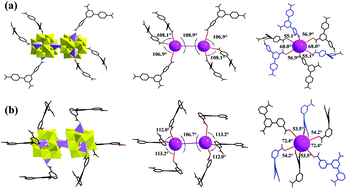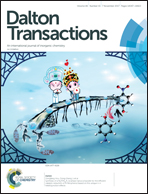Construction of (3,6)-connected polyoxometalate-based metal–organic frameworks (POMOFs) from triangular carboxylate and dimerized Zn4-ε-Keggin†
Abstract
Using the methodology of extension of reduced transition metal-grafted ε-Keggin polyoxoanions with two types of terphenyl-based tricarboxylates of H3L1 (3,5′,3′′-position substitution) and H3L2 (4,5′,4′′-position substitution) we isolated two (3,6)-connected 3D polyoxometalate-based metal–organic frameworks, [TBA]3[H3PMo12O40][Zn4L2] (1, YZU-105), and [TPA]3[H3PMo12O40][Zn4L1]·0.5H2O (2, YZU-106) (H3L1 = [1,1′;3′,1′′-terphenyl]-3,5′,3′′-tricarboxylic acid; H3L2 = [1,1′;3′,1′′-terphenyl]-4,5′,4′′-tricarboxylic acid; TBA = tetrabutylammonium; TPA = tetrapropylammonium). In both compounds, the building block was the dimerized form of Zn4-{ε-H3PMo12O40}. Such dimerization left six anchoring points for each dimer and, as a result, a 6-connected node was formed. Compounds 1 and 2 exhibited topologies of (4·85)3(4·82)6 and (65·10)3(63)6, respectively. This work illustrates that use of tri-carboxylate substitutions in different positions (3,5′,3′′-position/4,5′,4′′-position) in tripodal terphenyl-based ligands allows different extents of twisting of the peripheral aromatic ring with respect to the central ring, thereby giving rise to different extending directions and symmetries.



 Please wait while we load your content...
Please wait while we load your content...